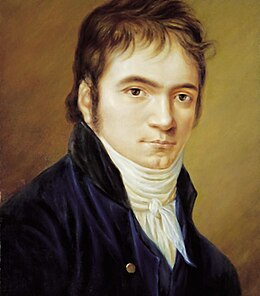Piano Concerto No. 1 (Beethoven)
| Piano Concerto in C major | |
|---|---|
| No. 1 | |
| by Ludwig van Beethoven | |

Beethoven in 1803, six years after he completed the piano concerto, his third attempt in the genre
|
|
| Catalogue | Op. 15 |
| Style | Classical period |
| Dedication | Princess Anna Louise Barbara Odescalchi |
| Performed | 18 December 1795: Vienna |
| Published | 1801 |
| Movements |
|
| Scoring |
|
Ludwig van Beethoven's Piano Concerto No. 1 in C major, Op. 15, was written in 1795, then revised in 1800. The first performance took place on 18 December 1795 in Vienna with Beethoven himself as soloist. It was first published in 1801 in Vienna with dedication to his pupil Princess Anna Louise Barbara Odescalchi (née Countess von Keglevics), known to her intimates as "Babette."
Although this was Beethoven's first piano concerto to be published, it was actually his third attempt at the genre, following an unpublished piano concerto in E-flat major of 1784 (not to be confused with Beethoven's more famous "Emperor" concerto, also in E-flat) and the Piano Concerto No. 2. The latter was published in 1801 in Leipzig after the Piano Concerto No. 1, but was composed over a period of years, perhaps beginning ca. 1788. Its first performance took place on 29 March 1795, several months before the concerto now referred to customarily as "No. 1."
As with the Piano Concerto No. 2, this C major concerto reflects Beethoven's assimilation of the styles of Mozart and Haydn, while its abrupt harmonic shifts demonstrate Beethoven's musical personality. It adheres to the concerto variant of sonata form and is scored for solo piano and an orchestra consisting of flute, 2 oboes, 2 clarinets, 2 bassoons, 2 horns, 2 trumpets, timpani, and strings. The flute, oboes, trumpets, and timpani are tacet during the second movement.
...
Wikipedia
